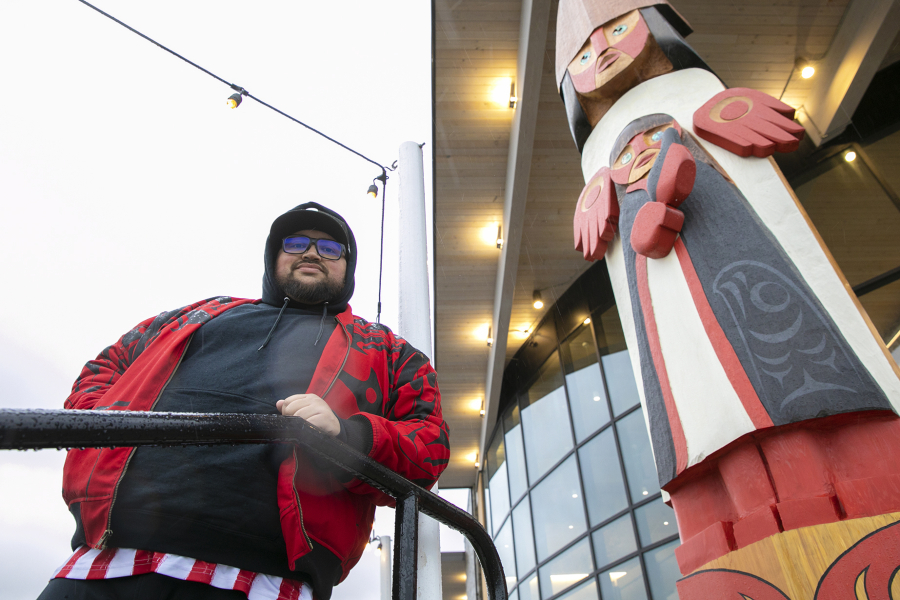EDMONDS — A 15-foot-tall woman with piercing eyes stares out over the Salish Sea.
She faces the Edmonds ferry dock, then the sea and, off in the distance, the Tulalip Reservation.
When the Edmonds Waterfront Center commissioned Ty Juvinel to carve a welcome figure, he knew he wanted to dedicate it to mothers — matriarchs by blood or by happenstance — who guide and strengthen communities.
“Mothers, grandmothers, they can see the potential you have that you don’t know yet,” said Juvinel, a member of the Tulalip Tribes. “They help push you in ways that sometimes you can’t see.”
Cut into a single, 500-year-old cedar log shipped down from Alaska, a grandmother towers with open, outward-facing palms. A young girl with matching iridescent eyes stands at her feet. Perched atop a base of salmon depicted in the Coast Salish style, the grandmother has handed the girl a traditional toy rattle, thus passing down her heritage.
“Our heritage is a gift,” Juvinel said. “And grandmothers are the pinnacle of knowledge.”
Juvinel named the figure Kay’s Gift, using the Lushootseed word for grandmother. Lushootseed is a Native language spoken by tribes in the Puget Sound region, including those whose descendants now live on the Tulalip Reservation.
After Juvinel’s father left when he was 8 years old, his grandmother Grace Goedel stepped in to raise him and his brothers, dutifully taking the kids to the bus stop each morning. In the evenings, when Juvinel’s mother would study medicine at the University of Washington, his grandmother would wait to walk them home.
When he was 11 years old, she put a set of carving tools in Juvinel’s hands. His grandfather taught him to carve a paddle, using bent blades, gouges and adzes to whittle away at the wood. He still has that paddle today — its Coast Salish salmon and bear designs peering up from the blades.
Goedel taught her grandchildren to have pride in their Indigenous heritage. She remembered her own grandmother, who spoke only Lushootseed, carrying Goedel on her back in a shawl while berry-picking or dehydrating clams — details she shared in a video for the Tulalip History Project.
Juvinel has carried those stories with him and into his artwork. But in his teens, he strayed from art.
“When I was younger, I was into fake stuff — trying to be a hoodlum or whatever,” he said, looking exasperated at the memory.
Juvinel worked in construction for a bit before deciding to go to school for audio-visual design. But as he prepared his final portfolio for graduation, tuition increased. Juvinel couldn’t afford to stay. He left one semester shy of graduating.
He found work with the Tulalip Tribes and, in doing so, found art again. Juvinel started “with the small stuff,” making paddles, rattles and masks. He spent time at the Boys and Girls Club and Hibulb Cultural Center, where he gave his art away.
“People never understand why I give away art for free,” Juvinel said. “I don’t want my art to just sit on someone’s mantle because they like the look of Coast Salish art. I want a child to play with the rattle — to interact with the culture.”
Winter air whistled through the cracks in the walls of Juvinel’s workshop Thursday on the Tulalip Reservation. Sitting near a portable heater, he brushed strokes of red into the eye of a Seattle Kraken logo he’d painted atop a handmade traditional drum. He planned to give it to the NHL team’s mascot as a gift to use on game day.
Juvinel explained that local teams imitate Native artwork, but they don’t actually showcase Native-made pieces often. If the NFL’s Seattle Seahawks or the Kraken are open to having Native-made artwork in their stadiums, he is happy to provide it.
“Our legends, our stories … it’s all put into wood grain,” he said. “Our community carries that legacy.”



